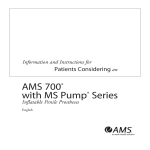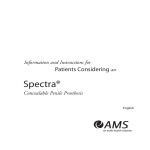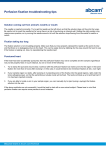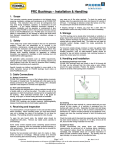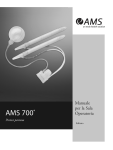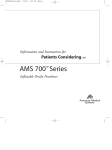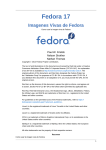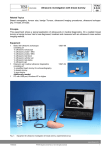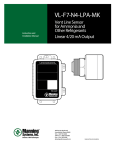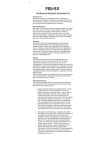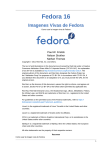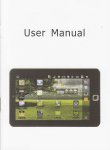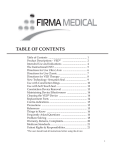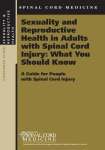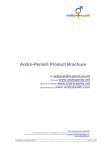Download AMS Ambicor™ - AMS Labeling Reference Library
Transcript
AMS Ambicor™ Penile Prosthesis Operating Room Manual English This page intentionally left blank. Table of Contents General Information Detailed Device Description................................................... 4 Device Characteristics............................................................. 4 Two-piece Device...............................................................................4 Easy to Inflate and Deflate.................................................................4 Device Function...................................................................... 4 Inflation.............................................................................................4 Deflation............................................................................................4 Device Components............................................................... 5 Cylinder Sizes.....................................................................................5 AMS Ambicor Packaging...................................................................5 Sterilization............................................................................. 5 Sterilization of Components...............................................................5 AMS Tools.........................................................................................6 Operating Room Instructions Operating Room Instructions................................................. 7 Preoperative Set-up Materials.............................................................7 Documentation..................................................................................7 Patient Preparation.............................................................................7 Unpacking the Device........................................................................7 Intraoperative Procedures ..................................................................8 Sizing...............................................................................................10 Method............................................................................................10 Inflate/Deflate Test...........................................................................10 Postoperative Procedures Postoperative Procedures....................................................... 11 Immediately Postoperative...............................................................11 After the Patient is Released from the Hospital................................11 Evaluating Long-Term Function and Placement..............................11 Procedure Illustrations Procedure Illustrations.......................................................... 12 Brief Summary Brief Summary ..................................................................... 14 3 General Information Detailed Device Description The AMS Ambicor™ Penile Prosthesis is a closed, fluid-filled system consisting of a pair of cylinders, which are implanted in the corpora cavernosa, and a pump which is implanted in the scrotum. All components are connected by kink-resistant tubing. The device is delivered prefilled with normal saline and preconnected. The cylinders are inflated as fluid is pumped from the reservoirs, which are located in the proximal ends of the cylinders, into the main cylinder body, creating an erection. They are deflated as fluid is transferred back to the reservoirs, making the penis flaccid once again. Device Characteristics Two-piece Device This prefilled and preconnected two-piece (pump and cylinders) device eliminates the need to fill and connect the device during surgery. Easy to Inflate and Deflate The inflation pump in the scrotum is easy for the patient to locate and requires few squeezes to inflate the device, because each squeeze displaces a large amount of fluid. To deflate the device, the patient simply bends the penis towards the scrotum, holds the position for 6-12 seconds, and then releases. Inflation Device Function Inflation The inflation pump is placed in the scrotum. To inflate the cylinders, the patient should stabilize the pump with one hand and use the other hand to squeeze and release the pump bulb several times to make the cylinders stiff. When the cylinders are fully inflated, the pump bulb will be hard and can no longer be compressed. Deflation To deflate the device, the patient places his thumb under the shaft of the penis to act as a fulcrum and his fingers on top of the shaft of the penis. Using the fingers of the same or opposite hand, the patient should bend his penis down over his thumb (fulcrum) towards his scrotum to a 55-65 degree angle, making sure that both cylinders are bent. The cylinders should be held in this position for approximately 6-12 seconds and then released. This will open the valves which allow the fluid to flow back into the reservoirs and pump. The patient may also deflate the device by bending the cylinders upwards; this can be done by placing his thumb on top of the shaft of his penis and following the same instructions as above. 4 Deflation General Information (continued) Device Components Sterilization Cylinder Sizes Sterilization of Components The AMS Ambicor penile prosthesis is provided in the following cylinder sizes: American Medical Systems sterilizes the Ambicor Penile Prosthesis and RTEs. Under normal storage conditions, the devices will remain sterile until the expiration date as long as the sterile barriers of the packaging remain intact. To protect the integrity of the packaging and the function of the prosthesis, store the sterilized devices on a protected shelf or in a cabinet. The environment should be clean, dry, and near room temperature. For maximum protection during storage, leave the Ambicor prosthesis and RTEs in their packaging. Inspect the packaging for damage and check the expiration date before use. Sizes (diameter by length) 12.5 mm x 14 cm 12.5 mm x 16 cm 12.5 mm x 18 cm 14 mm x 16 cm 14 mm x 18 cm 14 mm x 20 cm 15.5 mm x 18 cm 15.5 mm x 20 cm 15.5 mm x 22 cm AMS Ambicor Packaging The prosthesis is packaged in a fluid-filled inner pouch. The prosthesis is preconnected, prefilled, and sterilized in a pouch within a pouch system which is placed in a dustcover box. The proximal cylinder ends are secured in a protective cushion to minimize movement within the pouch. CAUTION: Do not reuse, reprocess, or resterilize the AMS Ambicor Penile Prosthesis or AMS Ambicor RTEs. They are intended for single use only. CAUTION: Do not use product that is past its expiration date. Rear tip extenders (RTEs) are packaged in the fluidfilled pouch with the Ambicor device. These RTEs include one pair each of 0.5 cm, 1 cm, 2 cm, and 3 cm RTEs. Ambicor RTEs are also available in a separate RTE kit that includes one pair each of 0.5 cm, 1 cm, 2 cm, and 3 cm RTEs, which is provided sterile. Each Ambicor prosthesis package also contains: • 2 Keith needles • Patient Information Form (PIF) • One mailing envelope to return completed PIF to AMS • Patient Medical Identification Card • Ambicor Instructions for Use NOTE: For warnings, precautions and contraindications please refer to the AMS Ambicor Instructions for Use provided in the product packaging. 5 General Information AMS Tools American Medical Systems has surgical instruments that can be used during the surgery to help facilitate the surgeon’s implantation of the penile prosthesis. For sterilization information, refer to the instructions provided with the tools. The following tools can be ordered from AMS. Non-sterile. These tools may be resterilized and reused. • AMS Sizer • Furlow Insertion Tool • AMS Closing Tool Sterile • Proximal Tool (dual use for cylinder insertion and closing) • Disposable Dilators • SKW Retractor Kit CAUTION: Do not resterilize or reuse the sterile tools. They are intended for single use only. CAUTION: Do not use product that is past its expiration date. 6 (continued) Operating Room Instructions Operating Room Instructions The following instructions are intended as a guide for the surgeon. CAUTION: This device is to be used only by physicians who are knowledgeable and have received appropriate training regarding the use of inflatable penile prostheses. This Manual is not intended to be a complete reference. Preoperative Set-up Materials The hospital should provide those instruments normally required for a urological surgical procedure. In addition to the AMS Ambicor penile prosthesis, you will need the following sterile setup: Patient Preparation Before the surgery, doctors should take adequate steps to limit the risk of post-operative infection. Once the patient is in the operating room, the abdominal and genital area should be shaved. Following the shave, the area should be scrubbed with povidone-iodine soap for ten minutes or in accordance with the approved hospital preoperative scrub procedure. Establish the sterile field, drape, and prepare the patient according to the physician’s instructions. Throughout the procedure, the surgical site should be flushed with copious amounts of broadspectrum antibiotics. Instruments: • 2 Keith needles provided in Ambicor packaging for passing cylinder traction sutures through glans • Corporal length measuring tool. • Furlow Insertion Tool for passing traction sutures through glans. • Corporal dilators (7mm-17mm) • 1 sterile surgical stand (Mayo stand) or a stainless steel tray • 1 basin of sterile normal saline • Antibiotic solution for irrigation (optional) • AMS Closing Tool (optional) The patient should be positioned so that a penoscrotal incision can be made. Documentation Keep the sterile pouches in the dustcover boxes until the components are in the operating room. Remove the pouches from the dustcover box in the operating room by opening the unlabeled end of the dustcover box. • One AMS Ambicor Penile Prosthesis Instructions for Use brochure • One Patient Information Form (PIF) • One mailing envelope for returning the completed PIF to AMS • One AMS Ambicor Patient Medical Identification Card Unpacking the Device NOTE: Do not unpackage the prosthesis until after the surgeon dilates and measures both corpora cavernosa intraoperatively. NOTE: The adhesive label at one end of the dustcover box and the small, peelable labels on the foil pouches show the part and serial/lot numbers and the size of the components. Record this information on and affix this label to the Patient Information Form (PIF). 7 Operating Room Instructions (continued) To remove the Ambicor device from its packaging: Intraoperative Procedures 1. Remove the inner fluid-filled foil pouch from the outer pouch. Surgical Procedures CAUTION: To avoid the possibility of cutting the Ambicor prosthesis or RTEs, do not cut the package open with scissors. 2. Place the sterile, fluid-filled foil pouch onto a sterile, lint free Mayo stand. CAUTION: Cloth towels placed on the Mayo stand may transfer lint to the AMS components. 3. Hold the foil pouch over a kidney basin containing sterile normal saline. Carefully tear the foil pouch at the side notch. Empty the Ambicor device, its RTEs, and the fluid into the kidney basin. Add sterile normal saline as needed to cover the components in the basin. NOTE: Do NOT leave the prosthesis exposed to air. Submerge the prosthesis in the fluid from the foil pouch or in sterile normal saline immediately after removing it from the foil pouch. Keep the prosthesis submerged until implantation to prevent air from entering the device. 4. Remove the tips of the Ambicor cylinders from the protective end cushion. 5. Discard the end cushion. 6. Leave the device and RTEs in the basin until ready to implant. Assemble the necessary equipment and position the patient for a penoscrotal surgical approach. The penoscrotal approach leaves the incision well hidden and provides convenient access to the corpora cavernosa. Establish the sterile field, drape and prepare the patient according to the physician’s instruction. Throughout the procedure the surgical site may be flushed with copious amounts of broad-spectrum antibiotic. The following description is an overview of the penoscrotal surgical approach. Penoscrotal Approach 1. To begin, place a Foley catheter to facilitate identification of the urethra. 2. Some physicians use the SKW Retractor System to place the penis on “stretch” to provide exposure of the corpora. 3. Make a 2 cm to 3 cm incision through the median raphe of the scrotum at the penoscrotal angle. Some physicians may prefer a high scrotal incision for better proximal corporal access. Then, laterally retract the corpus spongiosum to avoid damaging the urethra. 4. Dissect through to Buck’s fascia to expose the tunica albuginea. Place stay sutures to use as a reference point when measuring the corpora. Then, make an incision into one of the corpora cavernosa. 5. Dilate the proximal corpus (crus) and the distal corpus to create a space for inserting a penile cylinder. Dilate the corpus cavernosum to 13-16 mm. Note: the available Ambicor cylinders diameters are 12.5 mm, 14 mm, and 15 mm. 8 Operating Room Instructions After dilating one corpus cavernosum, incise and dilate the adjacent corpus cavernosum following the same procedure. 6. To select the cylinders and rear tip extenders that will fit the patient’s anatomy, measure each corpus proximally and distally using the Furlow Insertion Tool or appropriate measuring device (See Sizing section for choosing cylinder size.). As a general rule, the corporotomy is best placed when two-thirds of the total corporal measurement is distal to the incision and onethird is proximal. This facilitates the placement of the cylinders, and may avoid the need to extend the corporotomy during the procedure. 7. Select the appropriate size cylinders, apply rear tip extenders (if necessary), and use the insertion tool(s) to introduce the cylinders into the corpora cavernosa, as follows: a. When inserting the cylinder distally, use the Furlow Insertion Tool to put the penis on mild stretch. The tool should be palpable beneath the glans. (continued) During insertion, be sure that the Furlow Insertion Tool is in the ipsilateral corpora at the distal penis. Because the intracavernosal septum may be inconsistent distally, it is easy to cross over to the contralateral side. If you think you may have crossed over, place a dilator into the other side. If the cylinder does cross over, no repair is necessary. Simply remove the cylinder and place it correctly. NOTE: The corporal incision may need to be extended to ensure the input tube exits directly from the corporotomy. Once both cylinders are implanted, close the tunica albuginea. Place the AMS Closing Tool or the closing end of the Proximal Tool (or other suitable instruments) over the cylinder to protect it from inadvertant needle injury, so that the corporal body can be closed. This should be done with meticulous attention to hemostasis. 8. Use blunt dissection to form a pocket in the most lateral and dependent portion of the scrotum. b. First thread the pulling suture at the front of the cylinder through a Keith needle, then place the Keith needle in the insertion tool. 9. Insert the pump into the scrotal pocket. The tubing between the pump and cylinders should not be palpable to the patient. c. Insert the Furlow insertion tool distally into the corpora cavernosa and pass the needle through the glans. 10.After both the cylinders and pump are implanted, check the function of the prosthesis by inflating and deflating the device. d. Inflate the cylinders fully, then insert the proximal end of the cylinder. 11.Some physicians close the dartos in two layers with a running 2-0 absorbable suture. Close the skin. e. Deflate the cylinders by bending both evenly to 55-65 degrees and holding them for 6-12 seconds. f. Position the distal ends of the cylinders by pulling the traction sutures. g. Use the Proximal Tool to place the proximal cylinder ends into the corpora. 12.Apply a wound dressing. Leave the device partially inflated. Some choose to tape the penis to the abdomen overnight. In addition, a drain may be placed for 12 to 24 hours. For postoperative instructions, see the section entitled “Postoperative Procedures”. 9 Operating Room Instructions (continued) Sizing Inflate/Deflate Test Below is the recommended method of selecting cylinder sizes for the AMS Ambicor penile prostheses. After all components are implanted, inflate the device to check the quality of the erection and deflate to evaluate flaccidity. The penis should lie down close to the body when deflated. There may be some swelling that precludes a good flaccid result. Method This method allows the tubing to exit directly from the corporotomy. Follow the formula described below to select the appropriate cylinder length and number of rear tip extenders. If necessary, extend the length of the corporotomy. 1. Calculate the Total Corporal Length (Distal + Proximal) Example Distal Corporal Length 11 cm Proximal Corporal Length +8 cm Total Corporal Length 19 cm 2. Subtract 2 cm from the Total Corporal Length to obtain an Adjusted Measurement. Example Total Corporal Length 19 cm -2 cm Adjusted Measurement 17 cm 3. Select the closest cylinder size that is shorter than or equal to the Adjusted Measurement. Example Adjusted Measurement 17 cm Selected Cylinder Length 16 cm 4. Subtract the Selected Cylinder Length from the Total Corporal Length to determine the length of rear tip extenders required to fit the patient. Example Total Corporal Length 19 cm Selected Cylinder Length -16 cm Rear Tip Extender Length 3 cm 10 Postoperative Procedures Postoperative Procedures Immediately Postoperative After the surgery, some physicians partially inflate the cylinders for the first 24 hours. This will aid hemostasis. The physician may place a closed system drain in the abdomen to drain excess fluid from the incision site. After 24 hours, remove the dressing and completely deflate the cylinders. Support the penis on the abdomen for four to six weeks to obtain a straight erection. Taping the penis to the abdomen is the usual process. After the Patient is Released from the Hospital After the patient has returned home and the swelling from the surgery has subsided, the physician may ask the patient to pull down on the pump located in the scrotum to properly position it. Positioning the pump makes it easier for the patient to locate the pump. The frequency of positioning the pump is the physician’s decision. Some physicians have their patients position the pump several times daily. To position the pump in the scrotum, a patient should: 1. Locate the pump in the scrotum. 2. Grasp the pump firmly and carefully pull the pump down in the scrotum. The patient should gently pull the pump into a position close to the outer scrotal wall. After three to six weeks, the physician may instruct the patient to begin cycling the device for the first time. To cycle the device, the patient inflates and deflates the prosthesis several times. The cylinders must be fully inflated before they can be deflated. However, after the postoperative healing period, the pain should subside. Instruct the patient to inflate and deflate the prosthesis several times daily. Four to six weeks postoperatively, instruct the patient that it is possible to begin using the prosthesis to have gentle intercourse. To determine if the patient is ready to use the device: 1. Check the incision site to be sure that it has healed properly. There should be no redness, swelling, or drainage. Any of these things may indicate that an infection is present and the infection should be treated promptly with antibiotics. 2. Ask the patient about pain when cycling the device and observe the patient inflating and deflating the device. After determining that the patient knows how to operate the device and that the device is functioning correctly, inform the patient that it is possible to begin intercourse. Evaluating Long-Term Function and Placement After the postoperative healing period, the physician should continue to have contact with the patient at least on an annual basis to evaluate the function of the device. During the annual evaluation, ask the patient how the device is functioning and if he has noticed any changes in the function, for example, the cylinders losing rigidity. Also check the patient for signs of infection or erosion. If the patient is having mechanical difficulty with the device, or if there is infection or erosion present, revision surgery may be necessary. It may be painful for the patient the first few times that he inflates and deflates the device. 11 Procedure Illustrations Procedure Illustrations 12 1 2 3 4 5 6 7 8 9 Procedure Illustrations (continued) 10 11 12 13 14 15 13 Brief Summary Brief Summary The AMS Ambicor Penile Prosthesis is intended for use in the treatment of chronic, organic, male erectile dysfunction (impotence). These devices are contraindicated in patients who have active urogenital infections or active skin infections in the region of surgery. Implantation will make latent natural or spontaneous erections, as well as other interventional treatment options, impossible. Men with diabetes, spinal cord injuries, or open sores may have an increased risk of infection. Failure to evaluate and treat device erosion may result in infection and loss of tissue. Implantation may result in penile shortening, curvature, or scarring. Possible adverse events include, but are not limited to, urogenital pain (usually associated with healing), patient dissatisfaction, mechanical malfunction, auto-inflation, penile curvature or sensation change, urogenital hematoma, urogenital edema, and infection. Prior to using these devices, please review the Instructions for Use for a complete listing of indications, contraindications, warnings, precautions, and potential adverse events. Rx Only. 14 This page intentionally left blank. 15 American Medical Systems Australia Pty Ltd. Unit 31, Building F 16 Mars Road Lane Cove NSW 2066 Australia Tel: + 61 2 9425 6800 Fax: + 61 2 9427 6296 American Medical Systems do Brasil Produtos Urológicos e Ginecológicos Ltda. Av. Ibirapuera, 2907 conj 1212 São Paulo-SP CEP 04029-200 Brasil Tel: + 55 11 5091 9753 Fax: + 55 11 5091 9755 American Medical Systems Canada Inc. P.O. Box 461 Guelph, Ontario N1H 6K9 Canada Tel: +1 519 826 5333 Fax: +1 519 821 1356 American Medical Systems, Inc. U.S. Headquarters 10700 Bren Road West Minnetonka, MN 55343 USA U.S. Toll Free: 800 328 3881 Tel: +1 952 930-6000 Fax: +1 952 930-6157 www.AmericanMedicalSystems.com American Medical Systems Europe B.V. Haarlerbergweg 23 G 1101 CH Amsterdam Zuid-Oost 0086 The Netherlands Tel: +31 20 593 8800 [email protected] ™ The denoted marks are trademarks or registered trademarks of American Medical Systems, Inc. ©2013 American Medical Systems, Inc. All rights reserved. Printed in USA. 1005514 P/N 22000018 (A/W Rev H) en
















